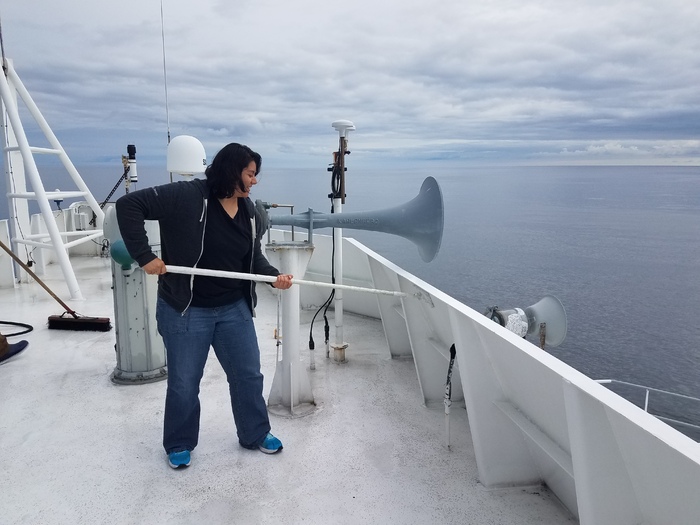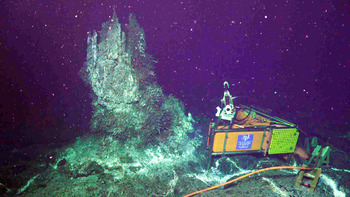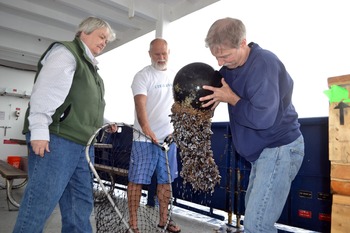With so much going on and something interesting happening everyday there are many new developments to come!
July 10, 2018
The morning started loudly with an engine room tour that felt more informative than the one from last year. This might have to do with the fact that I felt more comfortable asking questions since I have daily interactions with the Captain, Chief Engineer, and Oilers. While in the engine room, the Captain let me test the sound generated phone by calling the bridge and then asking them to call the engine room back. The 3rd mate Toby sounded confused when he answered until I told him I had permission, but it was hard to hear with all the noise so I wasn’t quite sure what he said.
After both lunch and dinner, I collected more samples from the CTD. I’ve collected quite a few samples now and gained more experience since last year’s cruise. For my project I managed to get my LED adjusted over the flow tank to show the microplankton going by. I sent a photo of it to Danny in an email asking about the quality of the photo. It’s important to make sure the photos will work for what I plan to do, which is enhance the microplankton and eliminate the background. If the photo is clear enough then I should be ready to use the microscope next.
There were a lot of porpoises surfing in the wake of the ship after dinner. I got some good video of them on my phone. I was surprised at how close to the ship they were compared to the ones I saw last year. After helping with the CTD, Benjamin Brand showed me and others how to play Jungle Speed. It was a fast-paced card game about matching shapes and sometimes colors. I was pretty slow at grabbing the game’s totem, yet somehow won two matches. Erik said it could have been because of the funny noise I made every time I slowly reached for the totem, it would distract the other players from looking at my card.
At 10 p.m. Eve, Bing, and I went outside to look at the stars. I’ve never seen so many before, the city is just too polluted to get a good view. Even in Clallam Bay there weren’t that many to see. I counted two shooting stars in only 20 minutes! As the second leg draws near its end I will miss the other students, especially Bing who I’ve grown the closest to over the past two legs. I eagerly await the new adventures of the next two legs!
July 9, 2018
My morning shift began with a dive to cut the science pod loose from the 200 m platform. The winch cable had been tangled and frayed after just a few days of profiling due to a tight level wind. The science pod floated to the surface after being cut, and it had to be grabbed from over the side of the ship using a hook on a long pole and a crane. The ship positioned itself near the pod and Trina reached out and clipped it and later saying “it was super easy” when asked about it. Eve and I watched from the bridge with binoculars and spotted a large plastic jug floating in the water near the science pod. From a distance we were convinced it was a message in a bottle, but upon closer inspection it was empty. We wanted to scoop it out with the net, but it was too far gone by the time we had the science pod on deck. That has been the second floating debris I’ve seen during this cruise. I wasn’t on as long last year, but I didn’t see anything then, so this concerns me.
Between Jason coming up and the science pod being recovered, Eve and I stepped out of the control van and saw something very curious. There was a large puddle of water on the 02 deck sloshing around. We were concerned about it and then saw the cause: water was being drained overboard from off the ship. We followed the water fall to its source and saw that the crew was scrubbing the upper levels of the ship. After asking the Captain for permission to help, we went to the flying bridge and started scrubbing the deck. The crew found it unusual for us to want to help and questioned our intentions. That was the highest up on the ship I’ve been, so far. The captain said we could climb up to the satellite when we get to port if we ask Eric Wakeman to help us up and use harnesses.
After lunch Bing, Eve, and I helped get the RAS/PPS prepared for a washing. It was fun to climb in the junction box and connect everything. The three of us had a rhythm going soon, connecting the tubes, filling them with water, and tightening the caps. I really enjoyed the feeling of sitting on the edge of the jbox and feeling the wind in my freshly washed hair. It somehow felt different than sitting at the picnic table outside or on the walkway.
After dinner I made some progress on my project. I was able to successfully stop and run the command I need more than once, and the micro sd card I’m using has a lot of storage so I won’t have to worry about transferring the photos over for a while. I also built the covering for the base with the help of Eve, Bing, and Summer Farrell, now all I need to do before I can start using it properly is adjust the LED. Then I can set up the microscope!
During the night shift we saw an octopus under the CAMDS-2017. It followed Jason as we picked up the CAMDS and took it to the undervator. It was so cute! I hope it makes a new home under the new CAMDS-2018 that we deployed there. There were also quite a few lingcod and rockfish around the junction box.
Something funny that happened was when Julie came in and remarked about how fast the dive was going. She said it was planned to take five hours but would be finished sooner. When Eve showed her that the dive plan projected only three or so hours Julie exclaimed “What have I been doing these past three hours?!” This confirms that I’m not the only one who has trouble keeping track of time and what has taken place within it.
After recovery of the old CAMDS, Eve and I went to the back deck to scrape the anemones off it. They didn’t look well off, but we threw them back overboard in the hope that they might feel better. Some loss of life is to be expected in this line of science, but it’s always good to be respectful to all life when possible. Science and technology is always advancing, so I take solace in the thought that we are doing our best to help it progress, but for now I understand these methods are necessary.
July 5, 2018
Yesterday was the 4th of July and I had entirely way too much coffee. I started the morning with just a cup and then by 10 at night I had three more, two of which had chocolate ice cream in them. I’ve been jittery like crazy and Eve says I never blink every time she sees me. I didn’t sleep well because of the heartburn I had and how fast my heart was beating. After my 8pm-12am shift I went to the galley to have some left over mushroom burgers. I thought I was going crazy when watching the dive on the screen because the camera kept coming in and out of focus while zooming in and out. I was worried that my eyes were doing that themselves. Then today I’ve been stumbling around and over my feet while the ship is moving ever so gently, not enough to warrant this amount of looking like a buffoon.
Aside from my super heightened senses and reduced reflexes I’m doing fine. Last night’s shift was during J2-1065 and we visited El Antiquo, and Diva (a baby vent site). I was laughing with Eve because the dive plan mentioned “knocking over Diva” to place the flow meter over it. Its handle was wrapped in yellow and red electrical tape that made it took like a whack-a-mole hammer from a carnival game. I could imagine the Jason pilot slamming it into the vent for the full effect, but that didn’t happen, instead it was held over the vent. When the impeller stopped because of vent particles blocking it, Jasons' arm would shake it loose and it looked like we were making Jiffy Pop. My shift was over before we made it to El Guapo, but I heard there was new tube worm growth so I’ll check it out when doing the highlight video.
Bing and I got some video of Dr. Zumberge and Dr. Glen Sasagawa’s self-calibrating pressure sensor. Dr. Sasagawa gave us some great information on the sensor and the mundane things we don’t notice on the other instruments and the ship in general. For example, he pointed out that rubber washers were placed under the bolts on the instruments to prevent a current from forming between two different metals. It’s the little things like that I often overlook when taking in the big picture of an instrument, but every minute detail has a reason behind it. I feel like a possible idea for a student video for next year’s cruise could be on the science behind the minute mundane parts of the instruments and the ship, encompassing everything from the importance of knots to the bolts on the instruments.
Today I spent a good portion of the day making highlight videos and showing Eve how to make them. Bing and I are working on editing the sound quality of the video we took of Dr. Sasagawa’s pressure sensor. We have been really excited to see both Erik Fredrich and Dr. Sasagawa’s instruments be deployed and took advantage of getting them on many different cameras from different angles. We’ll be using 4K video and stills from Jason, and 4K video and stills from hand cams on deck prior to deployment. I was so happy they were deployed during our two shifts so that Bing and I could see it go down in person. After interviewing the both of them we’ll finally have enough to make the video. I’m excited!
While on the deck with Bing prior to deployment of SCPR and SCTAA the Captain pulled up a float with lots of gooseneck barnacles that had made their home on it. It was amazing getting to see the filter feeders in person as they stuck their cirri in and out, I had only seen it on video or in pictures before today. I don’t know what became of them though, because when I came back after recording the deployment the float was gone. With so much going on and something interesting happening everyday there are many new developments to come!
July 3, 2018
Since arriving at the Axial Seamount site some new developments have happened. Students are now taking two shifts in the control van because there are so few of us this leg due to extra scientists and engineers being onboard. Eve and I have the 8 am-12 pm shift and the 8 pm-12 am shift. I enjoy the night scene on the ship, it’s quiet yet still bustling with life. I’ve noticed there’s a sense of comradery among us night owls during shift change in the galley. After my second shift I enjoy a bowl of cereal and nod my head to the Jason and ship crew members as they grab their “morning” cup of coffee. It almost makes me wish I had the 12 am-4 am shift, just to see what the real night shift is like. In the control van there’s less people coming and going to see what’s on the screen, I enjoy the feeling of importance I get knowing that while others lay down to rest I help keep the operation running.
This morning while recording the MJ03B deployment on the 4K camera I paid closer attention to the outside world. When recording I usually only notice what’s happening on the camera screen, but today I noticed the noises that Jason makes as it’s moved around, the precise movements made with the cranes to get instrumentation into tight spots on a crowded back deck, and the way the Jason crew turns Jason to align it to latch. As Paul lead the crane back to its spot, it looked like he was flying a really heavy kite. The sounds Jason makes varies from a puppy’s whimper to a moose’s grunt. With such heavy equipment and nimble movements needed, taking in the entire deployment was like watching heavy weight lifters perform a graceful ballet, and I’m left with an interesting new perspective.
Carmen and Orest have helped me find the perfect place to set up my flow tank. The hydrolab has de-bubbled, uncontaminated seawater that drains over the side of the ship and I’ll be able to adjust the flow rate to my need. The tank had some leaks in it so I’ve put some sealant on it and it should be ready for me to use by tomorrow after lunch. The microscope I’ll be using came with instructions, slides, pipettes, everything I need and a cell phone camera adapter for taking photos! I found some great books on identifying plankton from the ship’s library, so I plan to use that when I look at them under the microscope. I really appreciate everything Kathy Newell has sent down for me, and Deb for arranging this, as well as Danny, Orest, Carmen, Erik, and everyone else who has helped me get this far with my project. I feel bad for not getting around to setting this up until now, but I still have the rest of the cruise to get data, hopefully I can get something worthwhile from all this.
It’s nearly 2 am, so here’s to sleep and the 4th of July!




